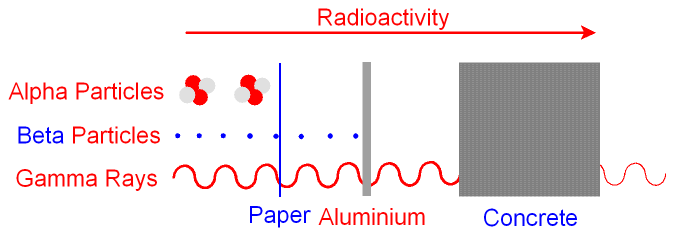
gcsescience.com 11 gcsescience.com
Penetrating Ability.
What is Penetrating Ability?
The ability of radioactivity to pass
through materials is called its
penetrating
ability. Penetrating
ability depends on the size of
the
radioactive particle. The table of the summary of properties
shows that alpha particles are the biggest,
beta particles are very much smaller and
gamma rays have
no mass.
The bigger the particle, the more likely it is to have a collision
with the atoms of the material.
The collision will stop the particle
going through the material.
Alpha particles are the
biggest and are least able to penetrate
a material.
Paper or smoke
particles will stop them.
Even in
air, alpha
particles can only
travel
for a few centimetres
before they are stopped by collisions with the air
molecules.
Beta particles are
stopped by a few millimetres of
aluminium
but some beta particles
will penetrate thin
aluminium foil or paper.
Gamma rays are the
most able to penetrate
and will even find their way through metres of concrete.
The picture
below shows the relative penetrating ability of
the three types of radioactivity.

When the particle or ray
collides with the material
it can knock an electron off the atom
and form
an ion.
Ionising ability is related to penetrating ability.
As penetrating ability increases, ionising
ability decreases.
![]() Links
Radioactivity
Revision Questions
Links
Radioactivity
Revision Questions
![]()
gcsescience.com Physics Quiz Index Radioactivity Quiz gcsescience.com
Home GCSE Chemistry GCSE Physics
Copyright © 2015 gcsescience.com. All Rights Reserved.